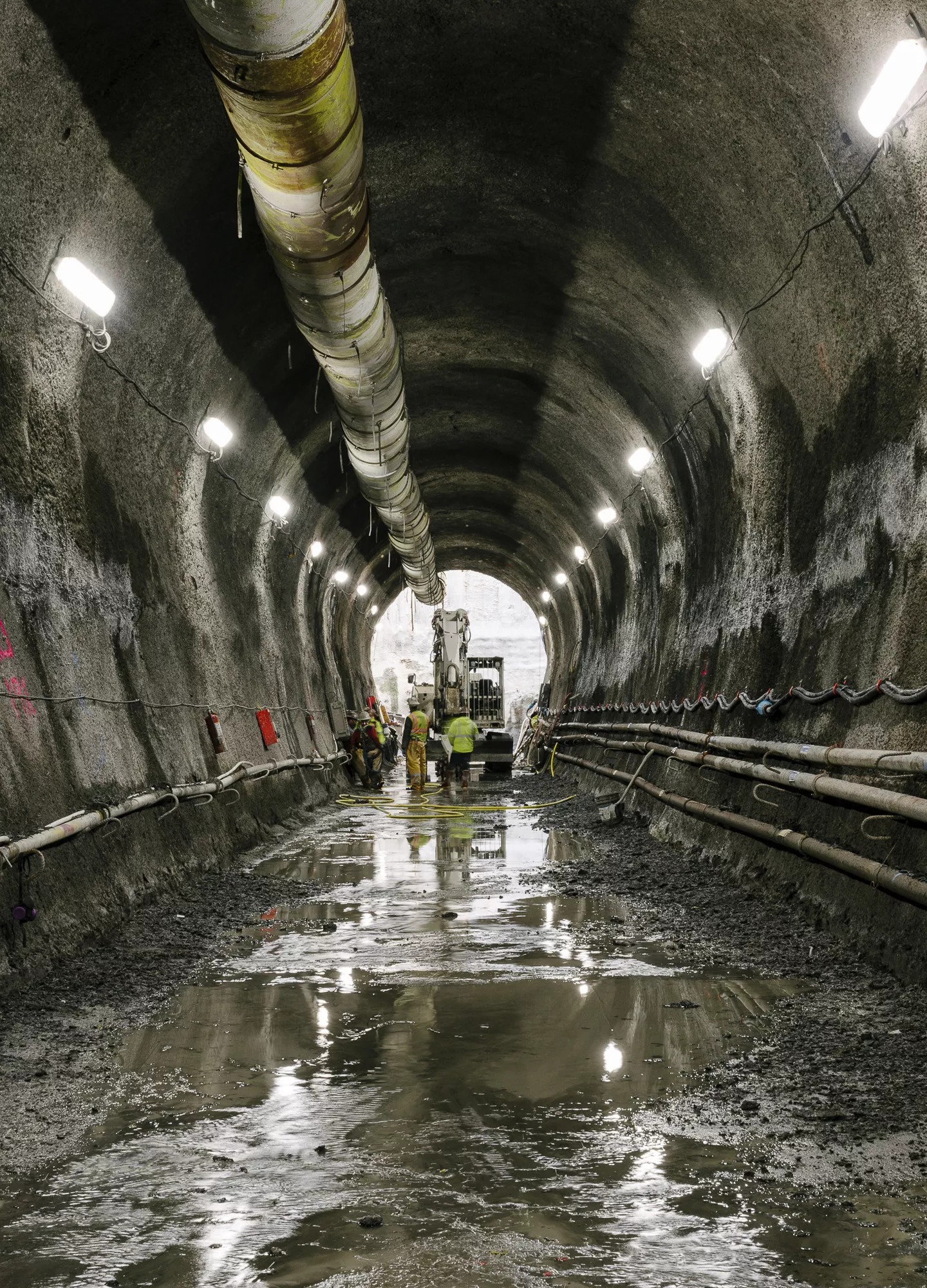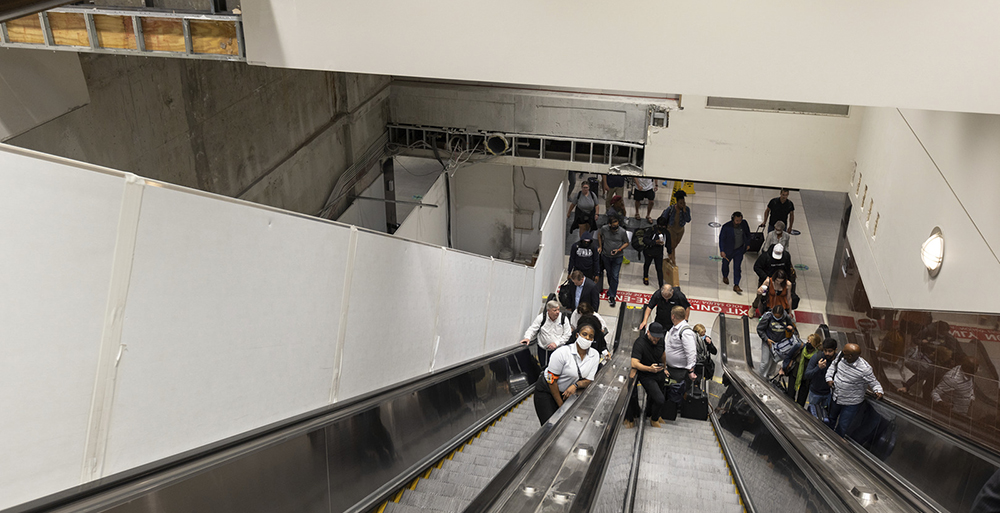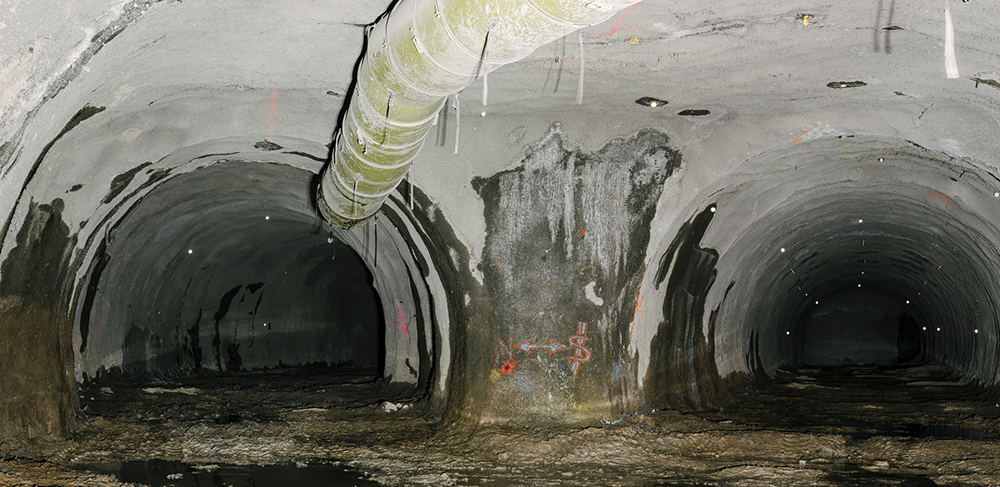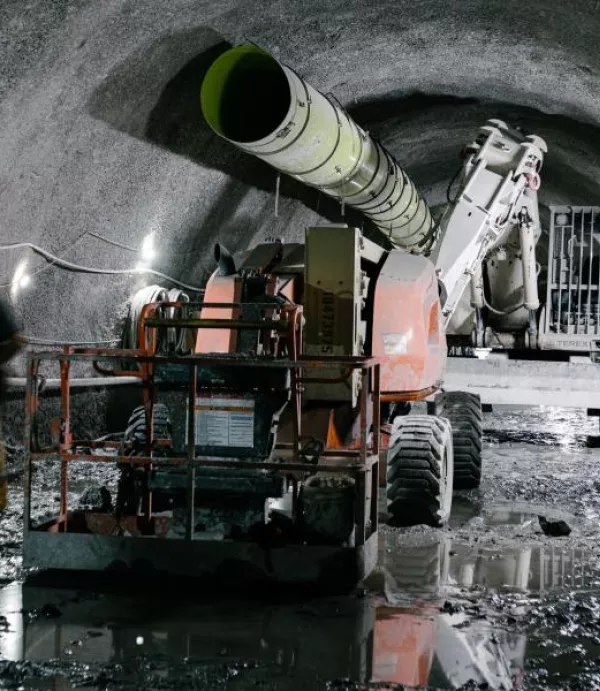On the Move at Hartsfield-Jackson Atlanta International Airport
July 25, 2022

The Plane Train Tunnel West Extension project at Hartsfield-Jackson Atlanta International Airport (HJAIA) is progressing on multiple fronts to improve passenger capacity of the Plane Train, the iconic automated people mover (APM) that connects the airport’s seven concourses with the domestic and international terminals. The project, which is being constructed by joint venture partners Clark Construction, Atkinson Construction, and Technique Concrete Construction (Clark/Atkinson/Technique), will enable the Plane Train to accommodate approximately 2,000 more passengers per hour, a 15-20 percent increase in service.
To create a more efficient train turnback operation, the tunnel expansion extends the train line 700 linear feet west from its existing terminus station at the Domestic Baggage Claim Station, under the MARTA and SkyTrain stations, and to the ground transportation area.
To accommodate the increase in service, renovations are also occurring at the Domestic Baggage Claim Station, including a new multi-level vertical transportation core, On the Move at Hartsfield-Jackson Atlanta International Airport which will increase capacity on the escalators and elevators that deliver passengers from the station platform to the main terminal boarding/ground transportation levels.
Image

The varied scope of work, which spans inside and underneath the Domestic Terminal, requires a unique combination of construction expertise. Clark’s extensive aviation experience, Atkinson’s self-perform sequential excavation method (SEM) tunneling capabilities, and Technique’s HJAIA experience, uniquely positions the Clark/ Atkinson/Technique joint venture team to deliver this critical infrastructure project to the City of Atlanta.
Collaboration and Flexibility Pave the Way for Success
The City of Atlanta’s Department of Aviation selected a progressive design-build approach for the Plane Train Tunnel West Extension project, the first ever progressive design-build tunnel project. This project delivery method provided opportunities for increased collaboration among Clark/Atkinson/Technique, the engineer of record, McMillen Jacobs Associates, and the client through the implementation of innovative design and construction approaches.
Unlike a traditional design-build delivery method where a single design solution is set at the beginning of the project, progressive design-build projects feature a more flexible and iterative design and procurement process. The progressive design-build approach has allowed pricing of work to occur in phases – capturing the design and construction challenges as the project progresses – thereby providing the team the opportunity to start construction of early phase work as design and procurement of later phases of work is ongoing.
During design, the team made several value engineering improvements to the project’s bridging documents including the elimination of a second construction access shaft, resequencing surface improvements above the construction shaft, and modifying the vertical circulation approach – all of which allowed the team to maximize cost-savings and eliminate project inefficiencies.
Brute Force of Tunnel Construction, Finesse of Interior Construction
While generally there are two separate but concurrent construction paths – one for the terminal work and one for the tunnel work – the two paths are dependent on each other to continue beyond specific milestones and, therefore, require extensive coordination amongst the design-build team and its trade contractors. The flexibility of the progressive design-build approach and the cross-market experience of the team has allowed Clark/Atkinson/Technique to consolidate decision-making and streamline critical path scopes, bringing together different in-house expertise to avoid potential slowdowns and miscommunications.
To create the turnback, the team is extending the existing north and south tunnels westward by 150 feet where they converge to a single tunnel at the 50-foot-by-50-foot bifurcation cavern. The single tunnel continues past the bifurcation for an additional 425 feet to a 30-foot finished diameter construction/egress and ventilation shaft.
Image

Excavation and installation of the tunnel’s initial support started in October 2020 and was completed in January 2022. The Clark/ Atkinson/Technique team used the sequential excavation method to mine the tunnels with a combination of excavators in the soft ground and drill-and-blast to mine through the rock. Over the course of 208 individual blast events, Atkinson used 45,000 pounds of explosives. The tunnel's initial support consisted of piles, face dowels, rock bolts, lattice girders, shotcrete, and welded wire fabric. The team is currently working on installing the tunnel’s waterproofing system and cast-in place concrete final lining with completion slated for March 2023.
With excavation taking place just five to ten feet beneath the Domestic Terminal and within three to five feet of MARTA and SkyTrain’s foundations, protection of existing adjacent structures and utilities was of the utmost importance. During design, the team conducted a structure verification study and assessed potential impacts. During construction, a state-of-the-art real-time ground and building monitoring system is used to monitor, analyze, and respond to any type of movement that might occur during construction.
Within the Domestic Terminal, significant work has already been completed in back-of house areas and the team has recently moved into the public areas of the airport. Back-of-house scope of work included extensive MEP relocations, underpinning of the Domestic Terminal’s columns to allow for the tunnel excavation to continue under the terminal, installation of support of excavation piles for the new elevators and elevator lobby, and demolition of walls.
Working almost completely at night so as not to disrupt passenger operations in the public areas, the team is currently installing a new elevator and associated lobby finishes on the east end of the platform, demolishing structural slabs and columns and existing finishes, installing structural steel in preparation for the upcoming installation of the new escalator, relocating and installing MEP, and installing finishes. Opening of the new north and south exit portals is scheduled for November 2022. Once the portals are operational, the team will then be able to close the current exit portal to complete installation of the two new glass elevators and video wall.


